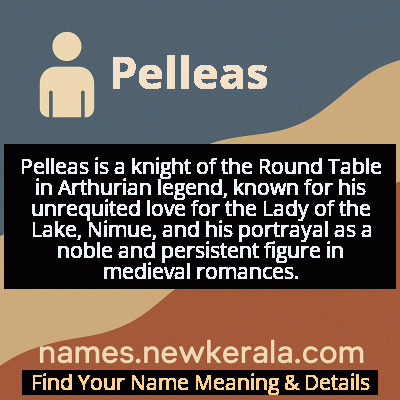Pelleas Name Meaning & Details
Origin, Popularity, Numerology Analysis & Name Meaning of Pelleas
Discover the origin, meaning, and cultural significance of the name PELLEAS. Delve into its historical roots and explore the lasting impact it has had on communities and traditions.
Name
Pelleas
Gender
Male
Origin
Arthurian
Lucky Number
7
Meaning of the Name - Pelleas
Pelleas is a knight of the Round Table in Arthurian legend, known for his unrequited love for the Lady of the Lake, Nimue, and his portrayal as a noble and persistent figure in medieval romances.
Pelleas - Complete Numerology Analysis
Your Numerology Number
Based on Pythagorean Numerology System
Ruling Planet
Neptune (Ketu)
Positive Nature
Intuitive, analytical, spiritual, and inquisitive.
Negative Traits
Secretive, reserved, aloof, and can be overly critical.
Lucky Colours
Green, yellow.
Lucky Days
Monday.
Lucky Stones
Cat’s eye, moonstone.
Harmony Numbers
1, 5, 6.
Best Suited Professions
Scientists, researchers, spiritual leaders, detectives.
What People Like About You
Depth of knowledge, analytical skills, spirituality.
Famous People Named Pelleas
Pelleas of Camelot
Arthurian Knight
Knight of the Round Table known for his unwavering love for Lady Ettarde and later association with the Fisher King mythology
Pelleas the Fisher King
Mythical Ruler
Guardian of the Holy Grail who represents spiritual decay and the need for redemption through the Grail quest
Sir Pelleas
Literary Character
Prominent knight in Thomas Malory's 'Le Morte d'Arthur' exemplifying courtly love and knightly perseverance
Name Variations & International Equivalents
Click on blue names to explore their detailed meanings. Gray names with will be available soon.
Cultural & Historical Significance
Extended Personality Analysis
The character of Pelleas embodies a complex psychological profile that combines traditional knightly virtues with profound emotional and spiritual depth. His initial portrayal reveals a man of intense emotional commitment and remarkable patience, particularly in his pursuit of Lady Ettarde where he demonstrates almost masochistic levels of devotion. This suggests a personality capable of deep, transformative love and extraordinary perseverance in the face of adversity. As the Fisher King, Pelleas evolves into a more symbolic figure representing spiritual suffering and the quest for healing. This aspect reveals a contemplative, introspective nature burdened by a mysterious wound that affects both his personal well-being and the health of his kingdom. The combination creates a portrait of someone who moves from external displays of chivalric virtue to internal spiritual struggle, making him one of the most psychologically developed characters in Arthurian literature. His journey suggests a personality that values authenticity over appearance, spiritual truth over social convention, and healing over conquest.
Modern Usage & Popularity
In contemporary times, the name Pelleas remains exceptionally rare and is primarily confined to literary and academic contexts rather than practical usage as a given name. Its appearances are almost exclusively within Arthurian scholarship, fantasy literature references, and occasional use in role-playing games or historical fiction. The name has never achieved any measurable popularity in birth records across English-speaking countries, maintaining its status as a distinctly historical and literary artifact. However, it enjoys a niche appreciation among Arthurian enthusiasts and fantasy aficionados who value its deep mythological roots and complex symbolic associations. The name's unusual phonetic structure and spelling present challenges for modern English speakers, contributing to its continued rarity. Despite this, it occasionally surfaces in creative works and academic discussions as an example of how Arthurian names carry rich symbolic weight and historical resonance, serving as a bridge between medieval literary traditions and contemporary interest in mythological naming.
Symbolic & Spiritual Meanings
Symbolically, Pelleas represents the profound connection between personal wounding and collective healing in Arthurian mythology. As the Fisher King, he embodies the concept of the 'wounded healer' archetype - a ruler whose personal suffering mirrors the spiritual malaise of his kingdom, and whose healing becomes necessary for the restoration of cosmic balance. His mysterious wound, often located in the thigh or groin, symbolizes both physical and spiritual impotence, representing how personal trauma can have far-reaching consequences. The Grail quest that seeks to heal him becomes a metaphor for the human search for meaning, redemption, and wholeness. Pelleas also symbolizes the transition from earthly chivalry to spiritual knighthood, representing how the ideal knight must evolve beyond mere martial prowess to embrace deeper spiritual responsibilities. His character serves as a living symbol of the interdependence between ruler and realm, personal virtue and collective well-being, and the idea that true nobility involves vulnerability and the courage to seek healing rather than simply projecting strength.

